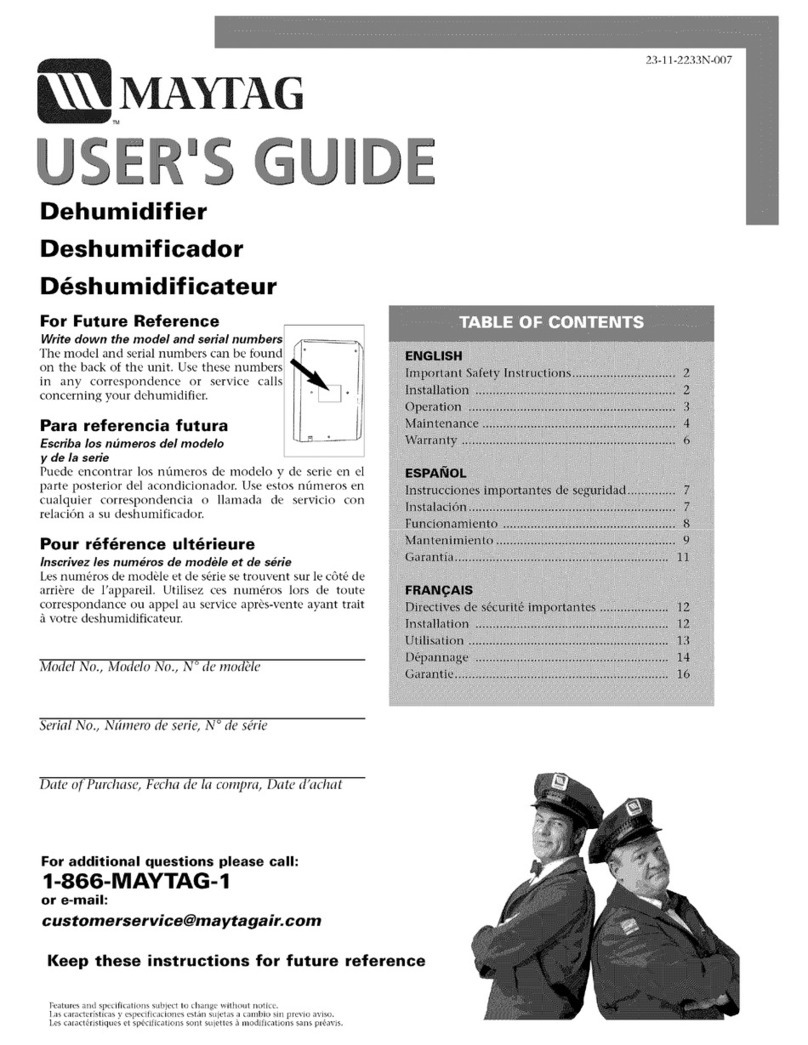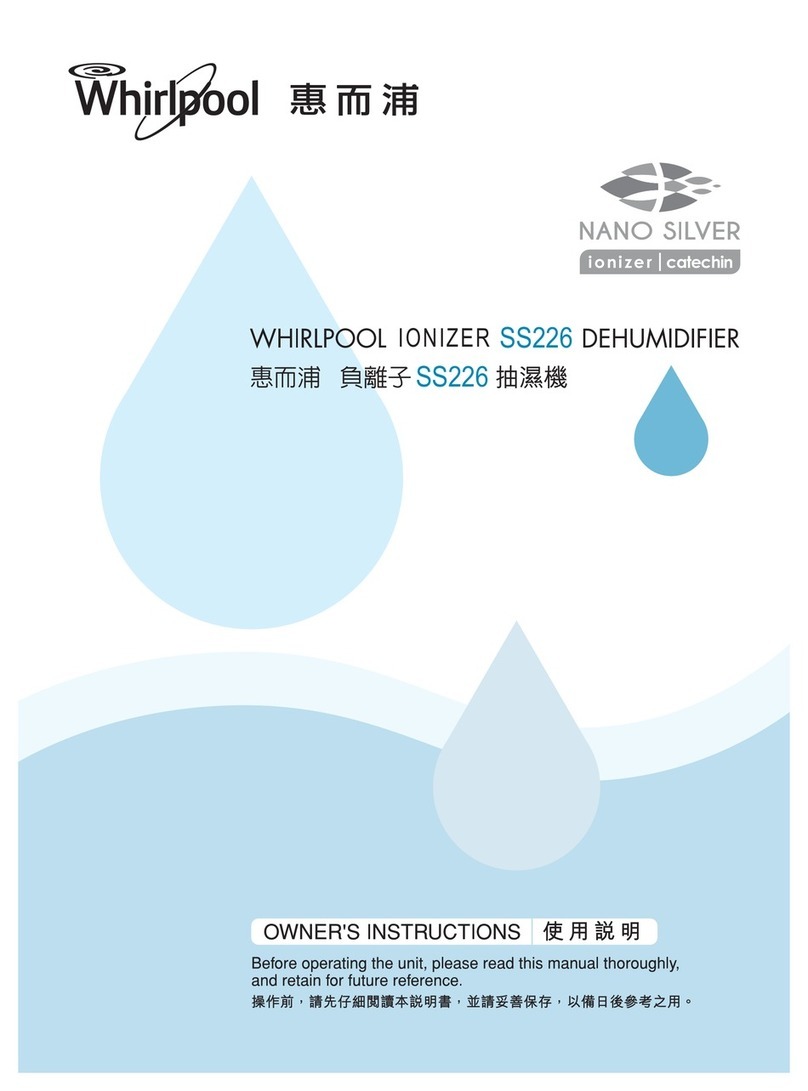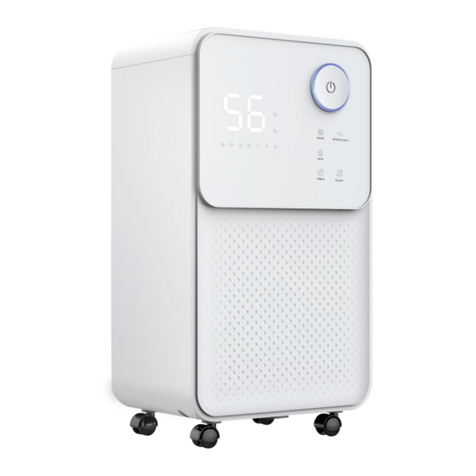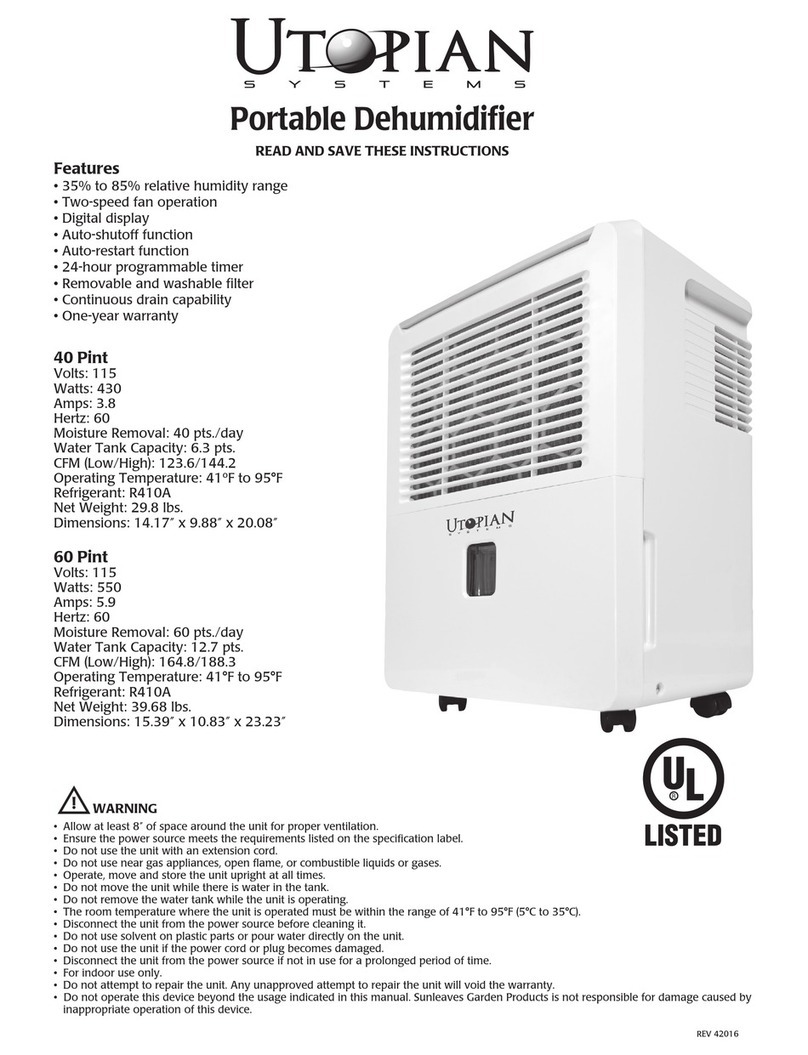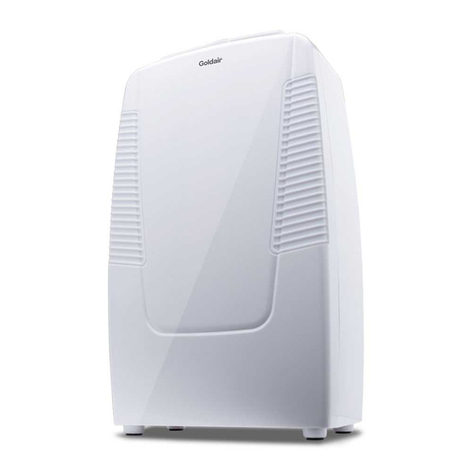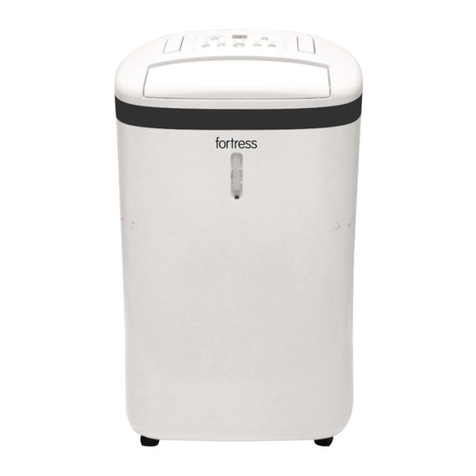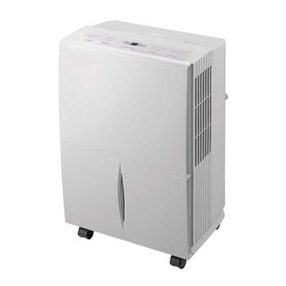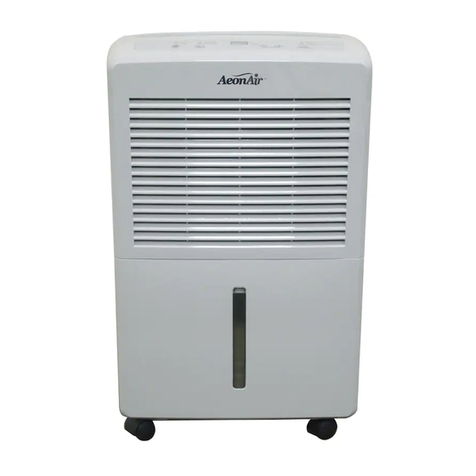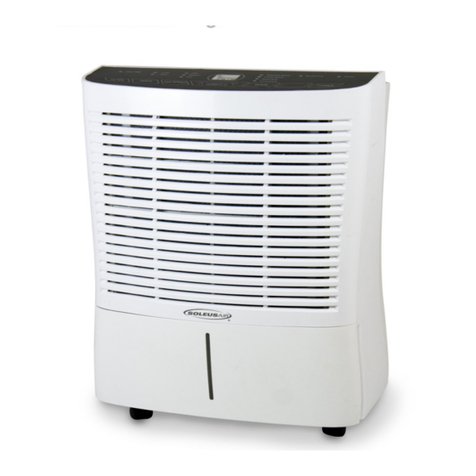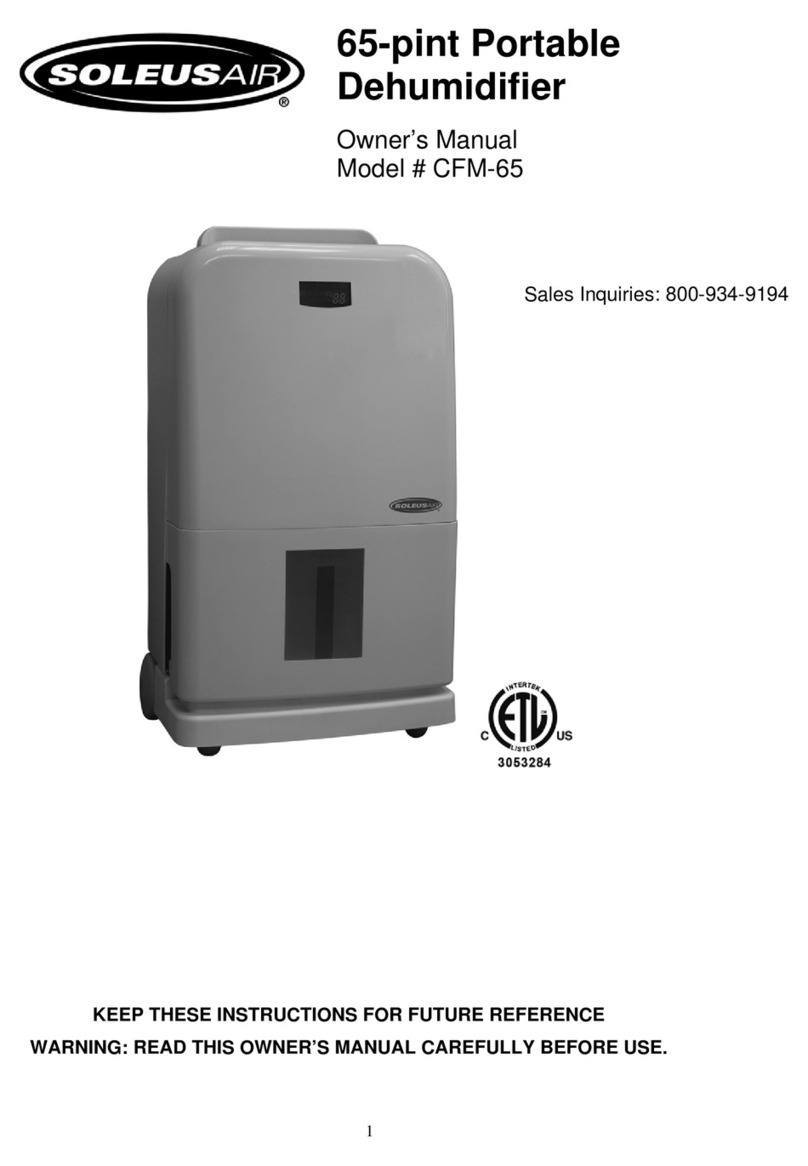SPX HCD Series User manual

Heat of Compression Desiccant Air Dryers
HCD SERIES
350 - 10000 scfm (595 - 16990 nm3/h)
FORM NO.: 7429789 REVISION: 03/2015 READ AND UNDERSTAND THIS MANUAL PRIOR TO OPERATING OR SERVICING THIS PRODUCT.
INSTRUCTION MANUAL

2
Contents
1.0 General Safety Information ...................... 3
2.0 Receiving, Storing, and Moving................ 3
3.0 Description ............................................... 4
4.0 Installation ................................................ 4
5.0 Instrumentation......................................... 7
6.0 Operation.................................................. 8
7.0 Maintenance............................................. 23
8.0 Troubleshooting........................................ 27
P&ID Schematic ............................................... 28
Electrical Schematic ......................................... 30
General Arrangement - 350 scfm ..................... 31
General Arrangement - 450 scfm ..................... 32
General Arrangement - 600 scfm ..................... 33
General Arrangement - 800 scfm ..................... 34
General Arrangement - 1025 scfm ................... 35
General Arrangement - 1300 scfm ................... 36
General Arrangement - 1500 scfm ................... 37
General Arrangement - 1800 scfm ................... 38
General Arrangement - 2100 scfm ................... 39
General Arrangement - 2400 scfm ................... 40
General Arrangement - 3250 scfm ................... 41
General Arrangement - 3700 scfm ................... 42
WARRANTY ..................................................... 43

3
1.0 General Safety Information
This equipment is designed and built with safety as a prime
consideration; industry-accepted safety factors have been
used in the design. Each dryer is checked at the factory for
safety and operation. All pressure vessels which fall under
the scope of ASME Section VIII, are hydrostatically tested
in accordance with the latest addenda. A factory-installed
safety relief valve is standard on each dryer.
WARNING — The following safety rules must be
observed to ensure safe dryer operation. Failure to
follow these rules may void the warranty or result in
dryer damage or personal injury.
1. Never install or try to repair any dryer that has been
damaged in shipment. See the Receiving and In-
spection instructions in this manual for appropriate
action.
2. This equipment is a pressure-containing device.
Never operate the dryer at pressures or temperatures
above the maximum conditions shown on the data
plate.
Never dismantle or work on any component of the
dryer or compressed air system under pressure. Vent
internal air pressure to the atmosphere before servic-
ing.
3. This equipment requires electricity to operate. Install
equipment in compliance with national and local elec-
trical codes. Standard equipment is supplied with
NEMA 4,4X electrical enclosures and is not intended
for installation in hazardous environments.
Never perform electrical service on the dryer unless
the main power supply has been disconnected. Parts
of the control circuit may remain energized when the
power switch is turned off.
4. Air treated by this equipment may not be suitable for
breathing without further purication. Refer to OSHA
standard 1910.134 for the requirements for breathing
quality air.
5. Certain parts of the dryer are not insulated and may
become hot during normal operation of the dryer. Do
not touch any of these areas without rst determining
the surface temperature.
6. Use only genuine replacement parts from the manu-
facturer. The manufacturer bears no responsibility for
hazards caused by the use of unauthorized parts.
Safety instructions in this manual are boldfaced for
emphasis. The signal words DANGER, WARNING and
CAUTION are used to indicate hazard seriousness levels
as follows:
DANGER—Immediate hazard which will result in severe
injury or death.
WARNING—Hazard or unsafe practice which could result
in severe injury or death.
CAUTION—Hazard or unsafe practice which could result
in minor injury or in product or property damage.
The dryer data plate, attached to the electrical control box,
contains critical safety and identication information. If the
data plate is missing or defaced, immediately contact your
local distributor for a replacement.
2.0 Receiving, Storing, and Moving
2.1 Receiving and Inspection
This shipment has been thoroughly checked, packed and
inspected before leaving our plant. It was received in good
condition by the carrier and was so acknowledged.
Immediately upon receipt, thoroughly inspect for visible
loss or damage that may have occurred during shipping.
If this shipment shows evidence of loss or damage at
time of delivery to you, insist that a notation of this loss or
damage be made on the delivery receipt by the carrier’s
agent. Otherwise no claim can be enforced against the
carrier.
Also check for concealed loss or damage. When a ship-
ment has been delivered to you in apparent good order,
but concealed damage is found upon unpacking, notify
the carrier immediately and insist on his agent inspecting
the shipment. The carrier will not consider any claim for
loss or damage unless an inspection has been made. If
you give the carrier a clear receipt for goods that have
been damaged or lost in transit, you do so at your own
risk and expense. Concealed damage claims are not our
responsibility as our terms are F.O.B. point of shipment.
Shipping damage is not covered by the dryer warranty.
2.2 Storing
Store the dryer indoors to prevent damage to any electrical
or mechanical components. All packaging material should
be left in place until the dryer is in position.
2.3 Handling
The dryer is designed to be moved by means of the ship-
ping skid or the base channels. The dryer may also have
lifting lugs for use with an overhead crane. Be sure to
attach all of the lift points and use appropriate spreader
bars to prevent damage to the dryer.
CAUTION — Never lift the dryer by attaching hooks
or slings to the piping, or to any part other than the
lifting lugs. Severe structural damage could occur.

4
3.0 Description
3.1 Function
Heat of Compression Air dryers are an economical and
reliable way to dry compressed air to dew points below
the freezing point of water. Desiccant dryers lower the
dew point of compressed air by adsorbing the water vapor
present in the compressed air onto the surface of the des-
iccant. Adsorption continues until equilibrium is reached
between the partial pressure of the water vapor in the air
and that on the surface of the desiccant.
These dryers continuously dry compressed air by using
two identical towers, each containing a desiccant bed.
While one tower is on-stream drying, the other tower is
being regenerated (reactivated, i.e. dried out). The towers
are alternated on- and off-stream so that dry desiccant is
always in contact with the wet compressed air. In this way
a continuous supply of dry air downstream of the dryer
is possible. The switching from one tower to the other is
controlled by a solid-state controller based on a xed time,
the time required to heat the off-line tower (standard) or
dew point basis (optional).
1. Fixed Cycle
When a tower is congured for regeneration, the
desiccant is regenerated by driving off (desorbing)
the water collected on its surface. Regeneration is
accomplished with the hot air from the nal stage
of compression. The elevated air temperature and
resultant low relative humidity creates the necessary
dry purge air for regeneration. The hot purge air
ows down through the desiccant bed, desorbs the
moisture from the desiccant, and carries the desorbed
water out of the tower. Heating continues until the
minimum drying time has expired at which time the
towers switch.
2. Standard Cycle
When a tower is congured for regeneration, the
desiccant is regenerated by driving off (desorbing)
the water collected on its surface. Regeneration is
accomplished with the hot air from the nal stage
of compression. The elevated air temperature and
resultant low relative humidity creates the necessary
dry purge air for regeneration. The hot purge air
ows down through the desiccant bed, desorbs the
moisture from the desiccant, and carries the desorbed
water out of the tower. Heating is “complete” when
the temperature of the air exiting the bottom of the
bed sensor rises to a preset level. The heating ow
rate and thus heat time will vary depending upon the
downstream air demand. High air demand will shorten
the time and low air demand will lengthen the heat
time. If heating completes quickly, purge air continues
to ow through the off-stream tower until the Minimum
Drying Time set point been met.
3. Dew Point Control (Option)
The regenerating tower is heated through in exactly
the same way as described previously; however, the
Dew Point Control makes use of an outlet dew point
transmitter sampling the dried air to monitor the outlet
air dew point and extend the drying period until the
bed capacity is exhausted before tower switchover is
initiated. Longer drying times extend bed life by mini-
mizing thermal cycling of the adsorbent. In addition,
extended drying times also minimize the frequency
of switchover temperature & dew point “spikes” and
increase overall reliability by minimizing valve cycles.
4.0 Installation
4.1 System Arrangement
Install the dryer as close as possible downstream of the
compressor to minimize temperature drop between the
compressor outlet and the dryer inlet. Air to the dryer must
be no more than 450°F and contain no oil liquids or vapors.
The standard dryer package includes a water-cooled heat
exchanger followed by a moisture separator to cool the
air and remove condensed water prior to passing into the
drying tower. The system is designed for 85°F maximum
cooling water temperature to achieve a maximum 95°F air
temperature to the drying bed. Temperatures above 95°F
(35°C) reduce drying capacity. Contact your local distribu-
tor for information on proper dryer sizing at elevated water
and/or inlet air temperatures.
To ensure downstream air purity (prevent desiccant dust
from traveling downstream) adequate ltration down-
stream of the dryer is required. A High Temperature
Afterlter, typically rated at 450°F (232°C) operating
temperature and capable of removing all desiccant nes
1 micron and larger should be installed at the dryer outlet.
WARNING — The afterlter, if installed, must be rated
for 450°F (232°C).
4.2 Ambient Air Temperature
Locate the dryer under cover in an area where the ambi-
ent air temperature will remain between 35°F (2°C) and
120°F (49°C).
NOTE: If dryer is installed in ambients below 35°F (2°C),
low ambient protection requiring heat tracing and insula-
tion of the separator bowl, auto drains, and lower piping
with inlet switching valves is necessary to prevent conden-
sate from freezing. If installing heat tracing, observe elec-
trical class code requirements for type of duty specied.
NOTE: Low ambient temperature increases heat loss
from the vessel shell, resulting in lower adsorbent regen-
eration temperature and higher outlet dew points. The
tower insulation option is recommended for installations
exposed to temperatures below 50°F.

5
4.3 Location and Clearance
Install the dryer on a level pad. Ensure the dryer is
level by grouting or shimming as necessary. Holes are
provided in the dryer base members for oor anchors.
Securely anchor the dryer frame to the oor. Allow 24
inches clearance on all sides of the dryer for servicing.
Provide adequate clearance for separator element and
afterlter element replacement. Provide protection for
the dryer if it is installed where heavy vehicles or similar
portable equipment is likely to cause damage.
4.4 Piping and Connections
All external piping must be supplied by the user unless
otherwise specied. Refer to the General Arrangement
Drawings in the back of the manual for connection sizes.
Inlet and outlet isolation valves and a vent valve are rec-
ommended so the dryer can be isolated and depressur-
ized for servicing. The connections and pipe ttings must
be rated for or exceed the maximum operating pressure
given on the dryer nameplate and must be in accordance
with industry-wide codes. Be sure all piping is supported.
Do not allow the weight of any piping to bear on the dryer
or lters. Piping should be the same size as or larger
than the dryer connection. Piping smaller than the dryer
connections will cause high pressure drop and reduce
drying capacity.
Consult the factory for piping details if required.
Dryer bypass piping may be installed to allow uninter-
rupted airow during servicing. If the downstream appli-
cation cannot tolerate unprocessed air for short periods,
install a dryer system in the bypass line.
CAUTION — Do not hydrostatically test the piping
with the dryer in the system. The desiccant will be
damaged if saturated with water.
Compressor Afterfilters ReceiverDesiccant Dryer
Figure 1
Typical System Conguration
4.5.1 Water Connections
Connect cooling water inlet and outlet. See Table 1 for
cooling water requirements.
Dryer Parallel
Exchangers
Water
Flow
Water
Connection(s)
Model Required GPM MPT
350 1 8.7 1.5
450 1 11.2 2.0
600 1 15.0 2.0
800 1 19.9 2.0
1025 1 25.6 2.0
1300 1 32.4 2.0
1500 2 37.4 2.0
1800 2 44.9 2.0
2100 2 52.3 2.0
2400 2 59.8 2.0
3250 2 81.0 2.0
3700 3 92.2 2.0
4425
5000
6100
7500
8500
10000
Consult Factory
TABLE 1
COOLING WATER REQUIREMENTS
(Maximum Cooling Water Supply Temperature: 85°F)
(Maximum Cooling Water Return Temperature: 120°F)
4.5.2 Automatic Condensate Drains
An automatic electric demand drain discharges condensate
removed by the separator. A second, timer drain, is
provided as back-up. Condensate should be piped to an
open, vented oor drain or sump. See Table 2 for expected
water ow from separator drain.
NOTE: Discharge is at system pressure. Drain line should
be anchored.

6
Model Peak Drain
Rate
scfm gph
350 4.0
450 5.1
600 6.8
800 9.1
1025 11.6
1300 14.7
1500 17.0
1800 20.4
2100 23.8
2400 27.2
3250 36.8
3700 41.9
4425
5000
6100
7500
8500
10000
Consult
Factory
TABLE 2
EXPECTED WATER FLOW FROM SEPARATOR
4.5 Electrical Connections
WARNING — These procedures require entering
gaining access to the dryer’s electrical enclosure(s).
All electrical work must be performed by a qualied
electrical technician.
Connect the proper power supply to the dryer according
to the electrical drawings in the back of this manual. Be
sure to follow all applicable electrical codes.
NOTE: A disconnect switch is not provided as standard
equipment and therefore, must be supplied by the
customer.
Dry contacts (voltage free) are provided in the low tension
electrical enclosure for a remote alarm. The contact
ratings are shown on the electrical drawing.
Connections to voltage-free common alarm contacts with
a minimum 5-amp rating can be made at terminals TB4-1
through 3.
• Terminal TB4-3 is the common alarm connection.
• Terminal TB4-1 is the N.O.. (normally open) contact
connection.
• Terminal TB4-2 is the N.C. (normally closed) contact
connection.
• The alarm relay coil is energized when power is sup-
plied to the controller input terminals and there are
no alarms.
• The coil is de-energized when power is removed or
when an alarm condition exists.
• The common alarm is designed to activate on:
a) either a dryer fault condition or a service reminder,
or b) a dryer fault condition. This is user selectable.
• For the common alarm to activate on either a dryer
fault condition or a service reminder, the jumper at
JP6 is removed. This is the default conguration.
• To have the common alarm activate on a dryer fault
condition only, the jumper at JP6 is installed.
4.5.1 RS-232 Connections
RS-232 connections can be made at the 3-pin connector
labeled J3 and located at the upper left-handed corner
of the control board. A cable for this connection can be
purchased through your distributor.
4.6 Initial Desiccant Charge
Heat of Compression Air dryers use activated alumina as
the desiccant in the dryer towers.
All desiccant shipped loose must be added to the
dryer towers before the dryer is put into service.
Refer to TABLE 3, DESICCANT REQUIREMENTS for
desiccant type and quantity per tower.
To Add Desiccant
WARNING — The following procedure provides in-
structions for adding the initial desiccant to the tow-
ers. If replacing desiccant, refer to the Maintenance
section of this manual.
1. Verify pressure gauges of both towers indicate 0 psig.
If not, depressurize the towers according to the shut-
down instructions in
the Operation section of this
manual
.
2. Remove the pipe plug or ll port ange cover (where
applicable) from the desiccant ll port at the top of
each tower. Refer to the General Arrangement draw-
ings in the back of the manual for the ll port location.
CAUTION – Pouring desiccant creates a ne dust;
safety goggles, gloves and a dust mask should be
worn by personnel installing desiccant. Refer to the
Material Safety Data Sheet that accompanies desic-
cant shipped loose for more complete information.
CAUTION – Do not tamp the desiccant in the towers.
Tamping damages desiccant and causes dusting.
3. Refer to Table 3 for desiccant quantity per tower.
When using Table 3 you will nd the desiccant quanti-
ties listed in layers. Each layer will vary in depth due
to the type, quantity and purpose of the desiccant.
Layer 1 must be installed rst at the bottom of the
tower followed by layer number 2 etc., until the com-
plete charge of desiccant has been installed.

7
4. Utilizing an appropriate sized funnel, ll each desic-
cant tower as follows:
a. Install the required quantity of tower media in layer
1 of each tower.
b. Level layer 1 and each subsequent layer of desic-
cant as added to each tower.
c. Finish lling each tower with desiccant until all
desiccant has been installed. LIGHT tapping
on the tower sides with a soft-face mallet should
yield additional free space to allow installation of
all desiccant required. DO NOT TAMP OR RAM
DESICCANT.
5. Clean the ll port closure. Replace the ll plug using
Teon tape or another pipe thread sealant suitable
for compressed air service. Reinstall ll port ange
cover (where applicable) in each desiccant tower.
Layer
Model
1 2
350 200#
1/4” bead AA*
—
450 200#
1/4” bead AA*
—
600 350#
1/4” bead AA*
—
800 350#
1/4” bead AA*
—
1025 450#
1/4” bead AA*
—
1300 575#
1/4” bead AA*
—
1500 675#
1/4” bead AA*
—
1800 90#
1/2” Bed Support
850#
1/4” bead AA*
2100 120#
1/2” Bed Support
925#
1/4” bead AA*
2400 120#
1/2” Bed Support
1075#
1/4” bead AA*
3250 180#
1/2” Bed Support
1375#
1/4” bead AA*
3700 300#
1/2” Bed Support
1625#
1/4” bead AA*
4425
5000
6100
7500
8500
10000
Consult Factory
* AA = Activated Alumina
TABLE 3
DESICCANT REQUIREMENTS
(Quantity per Tower)
5.0 Instrumentation
The following instrumentation helps in monitoring dryer
operation and performance. Instruments which are avail-
able as options are so noted.
Heat of Compression Air dryers are rated NEMA 4 and
include the following:
• Solid State Controls
• Tower Pressure Gauges
• Color Change Moisture Indicator
• Dryer Inlet, Left Tower, Right Tower & Dryer Outlet
Temperature Sensors
• Switch Failure Alarm (Option)
• Dew Point Transmitter (Option)
5.1 Controls
The solid-state dryer controls are located in a polycarbon-
ate, NEMA Class 4/4X, IP66 rated electrical enclosure
mounted to a center panel located between the two desic-
cant towers. Control features include:
• 15 LED’s to indicate operating status and fault condi-
tions.
• Two line text display to provide status and diagnostic
messages.
• Upon power loss, dryer “fails safe” (valves remain
in position). On power recovery, controller resumes
where power was lost.
5.2 Tower Pressure Gauges
Panel mounted gauges indicate pressure in each desic-
cant tower.
5.3 Color Change Moisture Indicator
A color-change moisture indicator mounted on the outlet
piping manifold that provides a constant visual indication
that dry gas is being supplied to the dryer outlet con-
nection. A sampling line installed at the dryer’s outlet,
supplies a small, continuous gas sample to the moisture
indicator for circulation.
As illustrated in Figure 2, the gas sample supplied from
the dryer outlet enters the moisture indicator’s inlet
connection (1), and circulates through a desiccant-lled
sight dome (2). The granular indicator (3), is a specially
treated “silica gel” which gradually changes from blue to
pink in color whenever a “wet” gas sample is received.
The color will return to blue when dry gas is once again
supplied to the dryer outlet. The indicator’s change

8
from blue (dry) to pink (wet), alerts personnel of a dryer-
associated moisture problem which requires investiga-
tion. The gas exits the indicator through a porous disc
(4) and then vents to atmosphere through an adjustable
bleed valve (5).
Figure 2
Color Change Moisture Indicator
5.4 Valve Switch-Failure Alarm (Option)
Limit switches are located on each switching valve to
trigger an alarm when any valve is not in the correct posi-
tion. If triggered, the dryer control system will energize
the red alarm LED on the control panel and de-energize
the common alarm relay. The alarm automatically clears
once the alarm conditions are corrected.
5.5 Dew Point Control (Option)
This option monitors and displays outlet pressure dew
points and provides an alarm signal if the dew point
exceeds user-specied set point. Recommended cali-
bration interval is 12 months. Contact the service depart-
ment for details.
Operation – The dew point is measured at the dryer oper-
ating pressure and is displayed in the operator interface.
When the controller is congured for Dew Point Control
mode, the on-stream tower will not switch and regenerate
until a predetermined dew point has been reached. This
elimination of unnecessary heat cycles extends dryer
desiccant and component life.
To protect the dew point transmitter from high tempera-
tures and dew point, a solenoid valve is used to isolate
the transmitter immediately after tower reversal.
If the dew point transmitter fails or reports a reading
outside of its operating range, the display will indicate a
sensor failure alarm condition. If the dryer is congured
for Dew Point Control mode when a transmitter alarm
occurs the controller will revert to the Standard Cycle until
the alarm condition clears.
6.0 Operation
6.1 Controls
A solid-state controller monitors all critical operating con-
ditions, and indicates operating status on a 2-line LCD
display operator interface. The controller receives input
data from temperature sensors, limit switches (option),
the Dew Point Transmitter (option) and the operator
interface. The operator interface displays information
about the dryer operating status and is used to change
the dryer operating mode.
6.2 Operating Modes
6.2.1 Automatic and Manual Advance
The drying and regeneration cycles are divided into
discrete steps. The operator selects either one of the
automatic modes (Fixed Cycle, Standard Cycle or Dew
Point Control) or manual advance mode (Manual Mode)
through the operator interface.
Selecting any of the automatic modes enables the
controller to advance the program step-by-step according
to the programmed schedule.
Setting up the controller for manual advance allows the
operator to advance the program one step at a time. This
mode is used for diagnostic purposes.
6.2.2 Fixed Cycle, Standard Cycle and Dew
Point Control
Fixed Cycle: Each tower is on-line (drying) for a set
minimum time period.
Standard Cycle: Each tower is on-line (drying) for a set
minimum time period plus any additional time required to
complete bed heating during low ow conditions. At lower
than design ow rates, the time required for bed heat-
ing will increase which will result in a longer drying time
between regenerations and fewer desiccant heat cycles.
Dew Point Control: Each tower remains on-line (dry-
ing) until the desiccant bed has been fully utilized. For
lower than designed moisture loads, this results in longer
drying cycles, longer time between regenerations and
fewer desiccant heat cycles. Dew Point Control is an
optional feature.
The operator interface is used to select the operating
mode.

9
6.3 Operating Sequence Description
(Refer to P&ID drawing in back of manual)
6.3.1 Fixed Cycle and Standard Cycle
1. Left Tower Regenerating – Right Tower Drying
Valves Opened:
• Left Purge Inlet Valve (V2)
• Left Purge Outlet Valve (V4)
• Right Drying Inlet Valve (V5)
• Right Drying Outlet Valve (V7)
Valves Closed:
• Right Purge Inlet Valve (V1)
• Right Purge Outlet Valve (V3)
• Left Drying Inlet Valve (V6)
• Left Drying Outlet Valve (V8)
Flow:
Hot compressed air ow:
a. Left Purge Inlet Valve (V2)
b. Left Tower – owing downward as previously
adsorbed moisture is removed from the desic-
cant.
c. Left Tower Purge Outlet Valve (V4)
d. Purge Air Cooler – The compressed air ow
is cooled before being dried.
Cool compressed air ow:
e. Purge Air Separator – removes condensed
water from the air to be dried
f. Right Tower Drying Inlet Valve (V5)
g. Right Tower – owing upward as the air is
dried
h. Right Tower Drying Outlet Valve (V7) - Dry
air exits the dryer
Fixed Cycle: The towers switch after the minimum
drying time has expired.
Standard Cycle: When the Left Tower has heated
through it is fully regenerated and ready for another
drying period. The Left Tower continues to heat until
heated through as detected by the temperature sen-
sor in the lower pipe manifold. Once the Left Tower is
heated through the towers switch once the Minimum
Drying Time expires.
2. Right Tower Drying – Left Tower Regenerating
Operation is as described above except all valves
positions are opposite.
State Transition Conditions
ID State
Description
Fixed
Cycle
Standard
Cycle
Dew Point Control
Cycle
Manual
Cycle
0 Left Heat (1)
Transition to:
Left Heat (2)
State Timer >
Fixed Heat (1) Time
LT Temperature >
Heat (1) Complete Temperature
LT Temperature >
Heat (1) Complete Temperature
Manual Advance
Button Pressed
1 Left Heat (2)
Transition to:
Left Standby
Drying Timer >
Minimum Drying Time
LT Temperature >
Heat (2) Complete Temperature
LT Temperature >
Heat (2) Complete Temperature
Manual Advance
Button Pressed
2 Left Standby
Transition to:
Right Heat (1)
Drying Timer >
Minimum Drying Time
State Timer > Standby Time
AND
Drying Timer > Minimum Drying Time
Dew Point > Dew Point Control Set Point
AND
Drying Timer > Minimum Drying Time
Manual Advance
Button Pressed
3 Right Heat (1)
Transition to:
Right Heat (2)
State Timer >
Fixed Heat (1) Time
RT Temperature >
Heat (1) Complete Temperature
RT Temp >
Heat (1) Complete Temperature
Manual Advance
Button Pressed
4 Right Heat (2)
Transition to:
Right Standby
Drying Timer >
Minimum Drying Time
RT Temperature >
Heat (2) Complete Temperature
RT Temperature >
Heat (2) Complete Temperature
Manual Advance
Button Pressed
5 Right Standby
Transition to:
Left Heat (1)
Drying Timer >
Minimum Drying Time
State Timer > Standby Time
AND
Drying Timer > Minimum Drying Time
Dew Point > Dew Point Control Set Point
AND
Drying Timer > Minimum Drying Time
Manual Advance
Button Pressed
TABLE 4
State Transition Conditions

10
6.3.2 Dew Point Control (option)
Operation of the DEW POINT Control is identical to the
Standard Cycle except the drying time is extended until
the desiccant bed in the on-line tower has been fully
utilized. The off-line tower is regenerated and remains
in a stand-by mode after being repressurized.
At tower switchover, a 2-way solenoid valve isolates the
dew point
transmitter
until the sequence advances to
“Heat(2)”. This protects the dew point
transmitter
from
the temperature and humidity “bump” that occurs at tower
switchover. The
transmitter
detects the dew point of an
outlet air sample then exhausts to atmosphere. The dry-
ing tower remains on-line until the outlet dew point rises
to the level set by the user through the Program Mode.
6.4 Control Board Jumpers
In the upper left hand corner of the control board there
are eight two-pin jumpers labeled JP1 through JP8. Only
four of the eight jumper pairs are utilized. The jumper is a
removable bridge that is used to make or break continuity
between two pins that form a pair. When installed in the
ON position, the jumper is place on both pins of the pair
and continuity between the pins is established. When
installed in the OFF position, the jumper is removed or
stored on a single pin and continuity is broken. Jumper
functions are as follows:
1. JP1 – Reserved
2. JP2 – Reserved
3. JP3 – Dew Point Transmitter
Jumper JP3 is installed in the ON position when a
Dew Point Transmitter is installed.
If DEW POINT CONTROL is not selected then the
dew point signal does not control the dryer cycle but
still serves a monitoring and alarm function.
4. JP4 – Low Inlet Temperature
Jumper JP4 is installed in the ON position to enable
Low Inlet Temperature Alarm.
5. JP5 – Reserved
6. JP6 – Common Alarm
Jumper JP6 is installed in the OFF position to en-
able both the dryer fault alarms and service alarms
to activate the common alarm. This is the default
conguration. Install jumper JP6 in the ON position
if the common alarm is to activated by a dryer fault
alarm only.
7. JP7 – Reserved
8. JP8 – MODBUS RS-232
Jumper JP8 is installed in the OFF position to enable
MODBUS RS-232.
6.5 Operator Interface
Refer to Figure 3, Front Panel Overlay for information
regarding the location and function of the LEDs, switches,
and text display.
6.5.1 Front Panel LED’s
• Power On - green
• Alarm - red
• Service / Maintenance reminder - amber
• Filters (separator, afterlter, and pilot) service / main-
tenance reminders - amber
• Switching valve status (On = valve open; Off = valve
closed) - green
• Left and right tower status (heating) - amber
• Left and right tower status (drying) - green
6.5.2 Front Panel Switches
The front panel contains four momentary-contact push-
button switches. Refer to Figure 3, Front Panel Overlay
for the appropriate icon associated with each switch.
Pushing on the overlay icon actuates the switch.
Data Display Switch
This switch is used to step through the display screens.
Select Switch
This button is located to the left of the text display window.
Refer to the Front Panel Operation Section for additional
information.
ENTER Switch
This button is located to the right of the text display
window. Refer to the Front Panel Operation Section for
additional information.
Alarm Reset Switch
This button is normally used to reset an alarm or service
reminder. Refer to the Front Panel Operation Section
for additional information.
6.5.3 Front Panel Operation
1. There are three controller menu modes for the Heat
of Compression Dryer.
a. Program Mode
b. Setup Mode
c. Display Mode
2. Each Mode is described below.
6.5.4 Program Mode
1. Press and hold and for 3 seconds to enter
Program Mode.
2. Program Mode is comprised of the screens that are
described below and over the next few pages and
illustrated in Figure 4.
3. There are three (3) ways to exit Program Mode.
a. Press after making the selection in the nal
screen.
b. At any screen, press and hold for 3 seconds.
c. The controller automatically exits Program Mode
if no button is pressed within 60 seconds.

11
Left Tower Drying LED
Left Purge Outlet Valve LED
On=valve open
Off=valve closed
Left Wet Inlet Valve LED
On=valve open
Off=valve closed
Left Tower
Heating LED
Separator Service /
Maintenance LED
Vacuum Fluorescent
Text Display
Select switch
Power On LED
Data Display Switch
Communications Icon
Filter Service /
Maintenance LED
Filter Service /
Maintenance LED
Right Dry Air Outlet Valve LED
On=valve open
Off=valve closed
Right Tower Drying LED
Right Purge Outlet Valve LED
On=valve open
Off=valve closed
Right Tower
Heating LED
Right Inlet Valve LED
On=valve open
Off=valve closed
Enter Switch
Maintenance / Service
Reminder LED
Alarm LED
Reset Switch for Alarm
Left Dry Air Outlet Valve LED
On=valve open
Off=valve closed
Figure 3
Front Panel Overlay
4. Upon exiting Program Mode the controller will switch
to Display Mode.
Screen 1: Select the Language
ENGLISH
1. Press to scroll through the choices: ENGLISH,
FRANCAIS and ESPANOL.
2. When nished, press to save the selection and
move to the next screen.
Screen 2: Select the Service Level
SERVICE LEVEL
NORMAL
1. Press
to toggle between NORMAL and SEVERE.
a. NORMAL Service Intervals are:
i. 4000 hours for lters
ii. 8000 hours for desiccant
iii. 8000 hours for valves
b. SEVERE Service Intervals are:
i. 2000 hours for lters
ii. 4000 hours for desiccant
iii. 4000 hours for valves
2. When nished, press to save the selection and
move to the next screen.
Screen 3: Reset the Timer for Filter Service
FILTER SERVICE
RESET? NO
1. Press to toggle between NO and YES.
2. When finished, press to acknowledge the
selection and move to next screen.
Screen 4: Reset the Timer for Valve Service
VALVES SERVICE
RESET? NO
1. Press to toggle between NO and YES.
2. When finished, press to acknowledge the
selection and move to next screen.

12
Dryer Conguration
SERVICE LEVEL
NORMAL
FILTER SERVICE
RESET? NO
ENGLISH
SERVICE LEVEL
SEVERE
SPANISH FRENCH
FILTER SERVICE
RESET? YES
Dryer Mode
CYCLE TYPE
STANDARD
CYCLE TYPE
DEW POINT
VALVES SERVICE
RESET? NO
VALVES SERVICE
RESET? YES
DESICCANT SERVCE
RESET? NO
DESICCANT SERVCE
RESET? YES
DEW POINT SETP
±XXX°C ±XXX°F
ALARM DEW POINT
XX MIN SW DELAY
ALARM DEW POINT
±XXX°C ±XXX°F
CYCLE TYPE
FIXED
MIN INLET SETP
±XXX°C ±XXX°F
MAX DRYING TEMP
±XXX°C ±XXX°F
MIN DRYING TIME
MINUTES: XXXX
BACK-UP DRAIN
AUTOMATIC
BACK-UP DRAIN
ENABLED
HEAT 2 SET POINT
±XXX°C ±XXX°F
CYCLE TYPE
MANUAL
HEAT 1 SET POINT
±XXX°C ±XXX°F
Heat of compression (UI Diagram)
Rev M - 04/23/20123 of 3
Conguration Menu:
Hold & for 3 seconds
Mode Menu:
Hold for 3 seconds
Figure 4
Program and Setup Mode Screen Illustrations

13
Screen 5: Reset the Timer for Desiccant Service
DESICCANT SERVICE
RESET? NO
1. Press to toggle between NO and YES.
2. When finished, press to acknowledge the
selection and move to next screen.
Screen 6: Set Minimum Drying Time
MIN DRYING TIME
MINUTES: XXXX
1. Press to increment the setting to the desired
value.
a. Standard set point is 30 minutes.
b. The allowable range of values is from 20 to 180
minutes in 5 minute increments.
2. When finished, press to acknowledge the
selection and move to next screen. Exit Program
Mode when there are no more active screens to
display.
Screen 7: Set the Heat (2) Complete Set Point
HEAT 2 SET POINT
±XXX°C ±XXX°F
1. Press to increment the setting to the desired
value.
a. Standard set point is 100°C (212°F).
b. The allowable range of values is a minimum 75°C
(167°F) to a maximum 150°C (302°F) in 5°C (9°F)
increments.
NOTE: The standard set point is suitable for
most applications. The set point is adjustable to
accommodate very low, or very high, compressor
discharge temperatures where an adjustment
may be required.
2. When finished, press to acknowledge the
selection and move to next screen. Exit Program
Mode when there are no more active screens to
display.
Screen 8: Set the Heat (1) Complete Set Point
HEAT 1 SET POINT
±XXX°C ±XXX°F
1. Press to increment the setting to the desired
value.
a. Standard set point is 75°C (167°F).
b. The allowable range of values is 65°C (149°F) to
“HEAT (2) COMPLETE SET POINT” minus 10°C
(18°F) in 5°C (9°F) increments.
NOTE: The standard set point is suitable for
most applications. The set point is adjustable to
accommodate very low, or very high, compressor
discharge temperatures where an adjustment
may be required.
2. When finished, press to acknowledge the
selection and move to next screen. Exit Program
Mode when there are no more active screens to
display.
Screen 9: Set the Minimum Inlet Temperature Set
Point
MIN INLET SETP
±XXX°C ±XXX°F
1. Press to increment the setting to the desired
value.
a. Standard set point is “HEAT (2) COMPLETE SET
POINT” plus 30°C (54°F).
b. The allowable range of values is: “HEAT (2)
COMPLETE SET POINT” plus 10°C (18°F) to
60°C (108°F) in 5°C (9°F) increments.
2. When finished, press to acknowledge the
selection and move to next screen. Exit Program
Mode when there are no more active screens to
display.
Screen 10: Set the Maximum Drying Temperature Set
Point
MAX DRYING TEMP
±XXX°C ±XXX°F
1. Press to increment the setting to the desired
value.
a. Standard set point is 40°C (104°F).
b. The allowable range is: 10°C (50°F) to 56°C
(133°F) in 2°C (4°F) increments.
2. When finished, press to acknowledge the
selection and move to next screen. Exit Program
Mode when there are no more active screens to
display.
Screen 11: Set Point for Dew Point Control
(Displayed only when JP3 “on”)
DEW POINT SETP
±XXX°C ±XXX°F
1. Press to increment the setting to the desired
value.
a. Standard set point is -5°C (23°F).
b. The allowable range of values is from -60°C
(-76°F) to 15°C (59°F) in 5°C (9°F) increments.
2. When finished, press to acknowledge the
selection and exit the Program Mode.

14
LT DRYING
RT HEAT (1)
LT DRYING
RT HEAT (2)
LT HEAT (1)
RT DRYING
LT HEAT (2)
RT DRYING
Dryer Status Screens Right Tower Drying Left Tower Drying
LT DRYING RT
xxx MINUTES xxx
HOURS TO SERVICE
FILTERS: XXXX
DRYER STATE
OUTLET DEW POINT
±XXX°C ±XXX°F
DEW POINT SETP
±XXX°C ±XXX°F
LEFT TEMP
±XXX°C ±XXX°F
RIGHT TEMP
±XXX°C ±XXX°F
INLET TEMP
±XXX°C ±XXX°F
Dryer State Screens (Standard/Fixed/Dew Point)
LT HEAT (1)
±XXX°C ±XXX°F
LT HEAT (2)
±XXX°C ±XXX°F
Right Tower Drying Left Tower Drying
Dryer State Screens (Manual)
RT HEAT (1)
±XXX°C ±XXX°F
RT HEAT (1)
±XXX°C ±XXX°F
HOURS TO SERVICE
VALVES: XXXX
HOURS TO SERVICE
DESICCANT: XXXX
OUTLET TEMP
±XXX°C ±XXX°F
LT DRYING
RT STANDBY
LT STANDBY
RT DRYING
LT STANDBY
±XXX°C ±XXX°F
RT STANDBY
±XXX°C ±XXX°F
NOTE:
LT Temperature
NOTE:
RT Temperature
HEAT 2 SET POINT
±XXX°C ±XXX°F
ALARM MESSAGE #1
ALARM MESSAGE #2
NOTE: Alarm message screens are shown after an alarm occurs
until alarm clears and the alarm reset button is pressed
NOTE: See Table 5 for alarm message text.
Heat of compression (UI Diagram)
Rev L - 03/27/20121 of 3
Figure 5
Dryer State and Status Screens

15
Screen 12: Set Alarm Point for the Dew Point
Transmitter (Displayed only when JP3 “on”)
ALARM DEW POINT
±XXX°C ±XXX°F
1. Press to increment the setting to the desired
value.
a. Standard set point is 0°C (32°F).
b. The allowable range of values is from a minumum
“DEW POINT CONTROL SET POINT” (set in
Screen 11) plus 5°C (18°F) to a maximum 20°C
(68°F) in 5°C (9°F) increments.
2. When finished, press to acknowledge the
selection and move to next screen. Exit Program
Mode when there are no more active screens to
display.
Screen 13: Set Alarm Delay for the Dew Point
Sensor (Displayed only when JP3 “on”)
ALARM DEW POINT
XX MIN SW DELAY
1. Press to increment the setting to the desired
value.
a. Standard set point is 5 MINUTES.
b. The allowable range of values is 1 to 10 MIN in
1 minute increments.
2. When nished, press to acknowledge the selection
and move to next screen. Exit Program Mode when
there are no more active screens to display.
Screen 14: Congure Back-up Drain Valve –
Automatic or Enabled
BACK-UP DRAIN
AUTOMATIC
1. Press to toggle between AUTOMATIC or
ENABLED.
In AUTOMATIC mode, electrical power is supplied to
the back-up drain circuit only in the event of a primary
drain failure. When the Back-up Drain is ENABLED,
the back-up drain circuit is continuously powered.
2. When finished, press to acknowledge the
selection and move to next screen. Exit Program
Mode when there are no more active screens to
display.
6.5.5 Setup Mode
1. Press and hold for 3 seconds to enter Setup
Mode.
2. Setup Mode is comprised of the screens that are
described below and illustrated in Figure 4.
3. There are two ways to exit Setup Mode.
a. Press
after making the selection in Screen 1.
b. The controller automatically exits Setup Mode if
no button is pressed with 60 seconds.
4. One of two things will happen upon exiting Setup
Mode.
a. The controller will switch to Display Mode if FIXED
CYCLE, STANDARD CYCLE or DEW POINT
CONTROL is selected.
b. The controller will switch to Manual Mode if
MANUAL CYCLE is selected.
Screen 1: Select the Cycle Type
CYCLE TYPE
STANDARD
1. Press to scroll through the choices:
a. STANDARD
b. FIXED
c. DEW POINT (displayed only when JP3 is in the
ON position)
d. MANUAL
2. When nished, press to save the selection and
exit the Setup Mode.
6.5.6 Display Mode
1. Display Mode is active when the user exits Program
Mode or Setup Mode.
2. Display Mode is comprised of Dryer State Screens,
Dryer Status Screens andAlarm & Service Messages.
6.5.6.1 Dryer State Screens
The State Screens show the current state of the drying
sequence. Examples of the dryer states are shown in
Figure 5.
6.5.6.2 Dryer Status Screens
By pressing the user can step through each of the
Dryer Status Screens. Examples of the dryer status
screens are shown in Figure 5.
6.5.6.3 Alarm & Service Messages
1. Local alarm consists of a blinking alarm LED and an
alarm message display.
2. After an alarm condition has been corrected:
a. The alarm LED stops blinking (LED on); the alarm
message continues to be displayed.
b. The alarm reset button must be depressed to clear
the alarm LED (LED off) and the alarm message.
c. When an alarm condition has not been corrected
and the “alarm reset” button is pressed, the alarm
will not clear.
3. Refer to Table 5 for explanation of alarm conditions.
4. Service Messages
There are two service levels (normal and severe) as
described in Program Mode. Each service level has
preset time intervals for servicing the lters, desiccant,
and valves. Time continues to accumulate as long as
power is supplied to the controller, whether the controller
is switched on or off

16
When a service time interval expires the controller oper-
ates as follows:
a. The service LED blinks and the appropriate service
message is shown on the text display.
i. When the service interval for lters has expired
(see also d below), the three lter LED’s also
blink.
b. The dryer continues to cycle normally
c. Press the Reset button to extinguish the service
LED and to clear the service message from the
text display
d. If the dryer has 1 or 2 lter monitors, the timer
for filter service is disabled. When the filter
monitor(s) send an alarm signal (change lter)
to the controller, the controller displays the same
LED’s and messages it would if the timer for lter
service had expired.
TABLE 5
Conditions for Alarm and Service Messages
(continued on next page)
RTD Alarm Conditions
Alarm Text Alarm Trigger Exit Condition States Alarm Action
ALARM LEFT TOWER
TEMPERATURE
SENSOR FAILURE
LT RTD < -28°C (-18°F)
OR
LT RTD > 454°C (849°F)
LT RTD > -28°C (-18°F)
AND
LT RTD < 454°C (849°F)
ALL Fixed Cycle
Activate alarm relay
Display local alarm message
ALARM RIGHT TWR
TEMPERATURE
SENSOR FAILURE
RT RTD < -28°C (-18°F)
OR
RT RTD > 454°C (849°F)
RT RTD > -28°C (-18°F)
AND
RT RTD < 454°C (849°F)
ALL Fixed Cycle
Activate alarm relay
Display local alarm message
ALARM INLET
TEMPERATURE
SENSOR FAILURE
Inlet RTD < -28°C (-18°F)
OR
Inlet RTD > 454°C (849°F)
Inlet RTD > -28°C (-18°F)
AND
Inlet RTD < 454°C (849°F)
ALL Activate alarm relay
Display local alarm message
ALARM OUTLET
TEMPERATURE
SENSOR FAILURE
Outlet RTD < -28°C (-18°F)
OR
Outlet RTD > 454°C (849°F)
Outlet RTD > -28°C (-18°F)
AND
Outlet RTD < 454°C (849°F)
ALL Activate alarm relay
Display local alarm message
ALARM INLET
LOW TEMPERATURE
Inlet RTD < Min. Inlet Temp1Inlet RTD > Min. Inlet Temp ALL Activate alarm relay
Display local alarm message
ALARM RIGHT TWR
HIGH INLET
TEMPERATURE
RT RTD > Max. Drying Temp. RT RTD < Max. Drying Temp 1,2 Activate alarm relay
Display local alarm message
ALARM LEFT TOWER
HIGH INLET
TEMPERATURE
LT RTD > Max. Drying Temp. LT RTD < Max. Drying Temp 4,5 Activate alarm relay
Display local alarm message
1Low inlet temperature alarm jumper must be installed.

17
Drain Valve Alarm Conditions
Alarm Text Alarm Trigger Exit Condition States Alarm Action
ALARM DRAIN
VALVE FAILURE
Demand drain valve common
alarm contact open
Common alarm contact closed ALL Activate alarm relay
Energize Backup Timer Drain
Display local alarm
Pilot Pressure Alarm Conditions
Alarm Text Alarm Trigger Exit Condition States Alarm Action
ALARM PILOT
LOW PRESSURE
Pilot pressure switch open Pilot pressure switch closed ALL Activate alarm relay
Halt cycle transitions
Display local alarm
Dew Point Control Alarm Conditions2(Option)
Alarm Text Alarm Trigger Exit Condition States Alarm Action
ALARM LEFT TOWER
OUTLET DEW POINT
Outlet dew point >
dew point alarm set point
AND dew point alarm delay
Outlet dew point <
dew point alarm set point
4,5 Activate alarm relay
Display local alarm
ALARM RIGHT TWR
OUTLET DEW POINT
Outlet dew point >
dew point alarm set point
AND dew point alarm delay
Outlet dew point <
dew point alarm set point
1,2 Activate alarm relay
Display local alarm
ALARM DEW POINT
SENSOR FAILURE
Dew point < -100°C (-148°F)
AND dew point alarm delay
Dew point > -100°C (-148°F) 1,2,4,5 Standard Cycle
Activate alarm relay
Display local alarm
2Dew point alarms are checked only when dew point transmitter is installed by setting the dew pointer installed jumper.
Valve Position Control Alarm Conditions (Option)
Alarm Text Alarm Trigger Exit Condition States Alarm Action
ALARM VALVE
LT DRY RT HEAT
IN2 contact open
AND
10 sec. delay
IN2 contact closed 3,4,5 Activate alarm relay
Display local alarm
ALARM VALVE
LT HEAT RT DRY
IN3 contact open
AND
10 sec. delay
IN3 contact closed 0,1,2 Activate alarm relay
Display local alarm
Service Messages
Alarm Text Alarm Trigger Exit Condition States Alarm Action
SERVICE DRYER
FILTERS
Filter service timer >
Filter service interval
Filter service timer reset ALL Display local alarm
SERVICE DRYER
VALVES
Valve service timer >
Valve service interval
Valve service timer reset ALL Display local alarm
SERVICE DRYER
DESICCANT
Desiccant service timer >
Desiccant service interval
Desiccant service timer reset ALL Display local alarm
TABLE 5
Conditions for Alarm and Service Messages
(continued from previous page)

18
6.5.7 Manual Mode
1. Manual Mode is active when the user exits Program
Mode after selecting operation in MANUAL CYCLE.
2. Manual Mode is comprised of six (6) screens (see
Figure 5 for examples of each screen). Each screen
corresponds to one of six (6) program states (de-
scribed in Table 4).
3. Press to advance from one screen (Manual step)
to the next.
IMPORTANT: Be sure to read and understand all
cautions listed with the screen (program step) de-
scriptions.
4. Upon entering Manual Mode, the program can be at
any one of the six steps.
5. To exit Manual Mode:
a. Press and hold for 3 seconds to exit Manual
Mode. The display switches to Screen 2 of Setup
Mode.
b. Use to select FIXED, STANDARD, or DEW
POINT CONTROL.
c. Press and hold for 3 seconds to exit Setup
Mode and activate Display Mode.
d. Dryer operation continues from the last step active
when exiting the Manual Mode.
6.6 Start-up
6.6.1 Controller Settings
Set or verify settings on Controller. Detailed operational
points are presented in section 6.5
WARNING - Enclosure may have live electric parts.
De-energize dryer before opening enclosure.
6.6.2 Initial Pressurization
SLOWLY pressurize dryer to full line pressure. (If the
dryer was installed with inlet and outlet isolation valves,
the inlet isolation valve should be slowly opened while
the outlet isolation valve remains closed.)
During initial start-up, check the entire system for leaks. If
necessary, de-pressurize the dryer and correct any leaks.
6.6.2.1 Dew Point Sensor (if installed)
Ensure that the supply air valve is open (one turn). When
the dryer is at any step other than LT Heat (1) or RT Heat
(1), open and adjust the sample exhaust valve until a
very slight, continuous gas bleed is felt exhausting out of
the sample cell. (Sensor is isolated with a solenoid valve
during LT or RT Heat (1) to protect it from the momentary
heat and high humidity condition which occurs at tower
switchover.)
6.6.3 Energizing the Dryer
Energize the dryer controls.
6.6.4 Bringing the Dryer Online
Establish a normal ow through the dryer. Slowly open
the outlet isolation valve if present. Close any dryer by-
pass valves.
6.7 Operational Check Points
6.7.1 Power to unit
Check periodically that there is power to the unit
(indicating lights illuminated).
6.7.2 Alarms
Periodically check for ashing red alarm LED.
6.7.3 Tower Status LEDs
Illuminated LEDs indicate which tower is on-line drying
or off-line regenerating.
6.7.4 Tower Pressure Gauges
Periodically check tower pressure gauges to verify that
the pressure gauges read line pressure.
6.7.5 Process Valves
Determine if air control valves are operating and
sequencing correctly.
6.7.5.1 Valves – Models 350 & 450
Switching valves are double acting, pneumatically piston-
actuated, Y-angle poppet valves.
A 12 volt DC, two position, 5-way pilot solenoid valve
wired to the controller is used to direct pilot air to the
actuators of the process switching valves.
6.7.5.2 Valves – Models 600 and above
Switching valves are High Performance Buttery Valves
with double acting pneumatic rack and pinion actuators.
A yellow arrow indicator located on the top of the actuator
output shaft points to valve position indicator icons. Pilot
air is directed to actuator ports to open both inlet valves
upon loss of power.
A 12 volt DC, two position, 5-way pilot solenoid valve
wired to the controller is used to direct pilot air to the
actuators of the process switching valves.
6.8 Dryer Shut Down
1. If the dryer installation is equipped with dryer bypass
and inlet and outlet isolation valves, the bypass valve
should be opened and the inlet and outlet isolation
valves closed.
2. De-energize the dryer’s electrical supply.
3. SLOWLY open the tower blow down valves (refer
to General Arrangement drawings in the back of the
manual for general location) to vent the dryer internal
pressure.
4. When all dryer pressure gauges indicate zero pres-
sure, close the tower blow down valves. Depres-
surization is complete.

19
6.9 Loss of Power
Control valves are designed so that upon loss of power
the air dryer is capable of drying air until the desiccant
exposed to the airow is saturated.
6.9.1 Power Recovery:
6.9.1.1 On loss of electrical power –
All controller outputs turn off causing the dryer operating
valves to remain in last position.
6.9.1.2 On restoration of power –
The sequence simply resumes at the step where power
was lost.
6.10 Using the RS-232 Port
The RS-232 port is used to monitor dryer operation from
a host computer.
RS-232 connections are made at the 3-pin connector
labeled J3 and located at the upper left-hand corner of
the control board. (See Figure 6)
Interface to a PC requires a (1 to 1) DB-9 cable.
Cable Pin Out:
- Data received by host computer on pin 2
- Data transmits from host computer on pin 3
- Ground is pin 5
- Jumper installed between pins 7 and 8
1
5
6
9
DB9 FEMALE
CONNECTOR
3-PIN HEADER ON
CIRCUIT BOARD
Figure 6
Wiring Diagram for RS-232 Port
Communication Parameters:
RS-232 Parameters
Baud Rate 9600
Data Bits 8
Parity None
Stop Bits 1
Flow Control None
Slave ID 1

20
Holding Register
Reference Address Name Units Description
40001 0x0000 DRYER_STATUS Integer State ID for the current dryer state
40002 0x0001 ALARM_STATUS Flag Bits Alarm ag bits
40003 0x0002 WARNING_STATUS Flag Bits Warning ag bits
40004 0x0003 SERVICE_STATUS Flag Bits Service ag bits
40005 0x0004 OUTLET_DEWPT Deg C Outlet air dew point
40006 0x0005 INLET_TEMP Deg C Dryer inlet air temperature
40007 0x0006 OUTLET_TEMP Deg C Dryer outlet air temperature
40008 0x0007 RT_TEMP Deg C Right tower air temperature
40009 0x0008 LH_TEMP Deg C Left tower air temperature
40010 0x0009 STATE_TIMER Minutes Current state time
40011 0x000A DRYING_TIMER Minutes Current drying tower time
40012 0x000B LAST_LEFT_TIMER Minutes Last left tower drying time
40013 0x000C LAST_RIGHT_TIMER Minutes Last right tower drying time
40014 0x000D FILTER_USAGE Hours Filter usage timer
40015 0x000E VALVE_USAGE Hours Valve usage timer
40016 0x000F DESICCANT_USAGE Hours Desiccant usage timer
40033 0x0020 DRYER_MODE Integer Dryer operating mode [0=Standard Cycle, 1=Dew Point Cycle, 2=Fixed Cycle, 3=Manual Cycle]
40034 0x0021 LANGUAGE Integer Language [0=English, 1=Spanish, 2=French]
40035 0x0022 SERVICE_LEVEL Integer Service level [0=Normal, 1=Severe]
40036 0x0023 FILTER_SRVC_TIME Hours Filter service interval
40037 0x0024 VALVE_SRVC_TIME Hours Valve service interval
40038 0x0025 DESICCANT_SRVC_TIME Hours Desiccant service interval
40039 0x0026 MIN_DRYING_TIME Minutes Minimum drying time set point
40040 0x0027 STANDBY_TIME Minutes Standby time set point
40041 0x0028 HEAT_1_TERM_TEMP Deg C Heat stage 1 termination temperature set point
40042 0x0029 HEAT_2_TERM_TEMP Deg C Heat stage 2 termination temperature set point
40043 0x002A MIN_INLET_TEMP Deg C Minimum dryer inlet air temperature set point
40044 0x002B MAX_DRYING_TEMP Deg C Maximum drying tower inlet air temperature set point
40045 0x002C DEWPT_CTRL Deg C Dew point control set point
40046 0x002D DEWPT_ALRM Deg C Dew point alarm set point
40047 0x002E DEWPT_DELAY Minutes Dew point alarm delay
40048 0x002F BACKUP_DRAIN Integer Back-up Drain [0=Automatic, 1=Enabled]
40065 0x0040 JUMPERS Flags Jumper ag bits
Modbus Registers
Table of contents
Other SPX Dehumidifier manuals
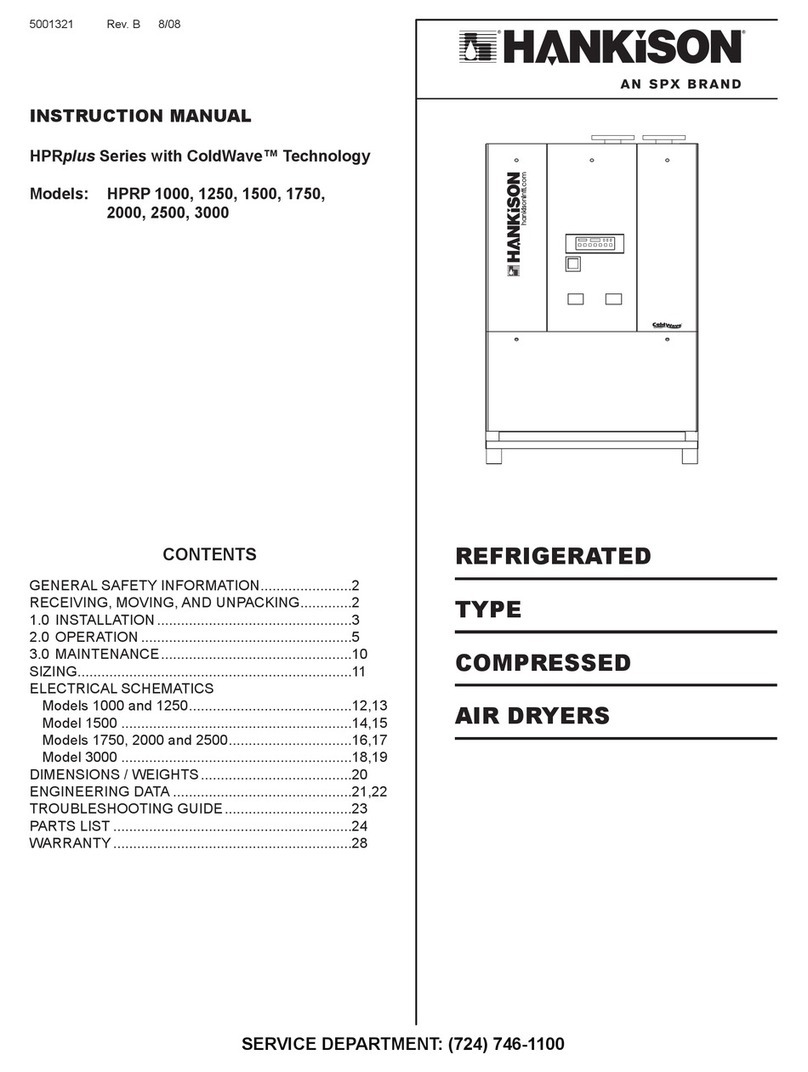
SPX
SPX Hankison HPRplus Series User manual

SPX
SPX Pneumatic Products IBP500 User manual

SPX
SPX DELAIR QD 90 User manual
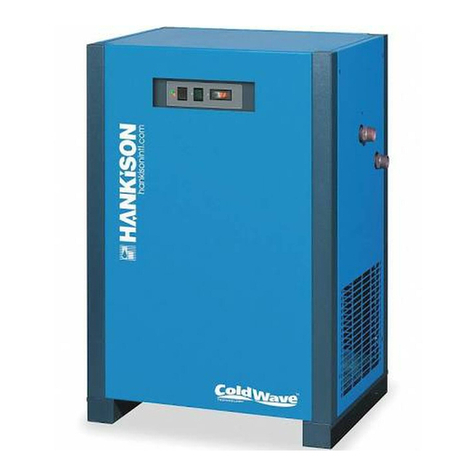
SPX
SPX Hankison HPRP Series User manual
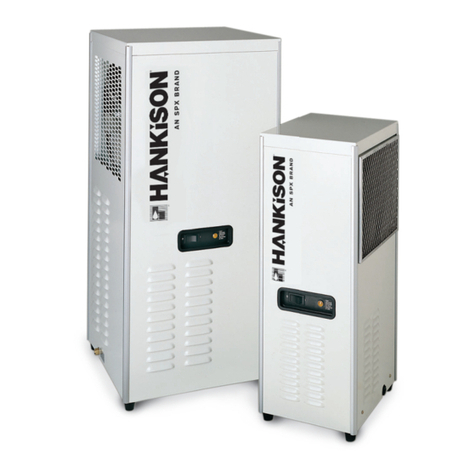
SPX
SPX HANKISON HIT Series User manual
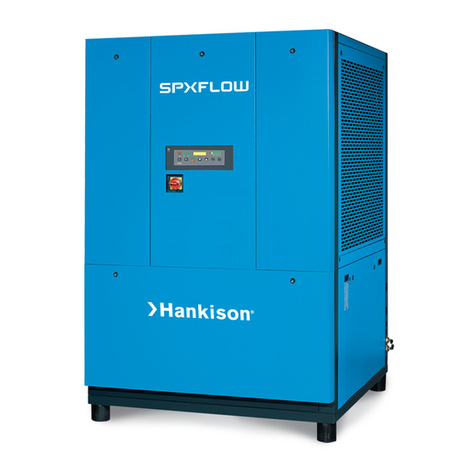
SPX
SPX HANKISON HES Series User manual

SPX
SPX Hankison GCU Series User manual
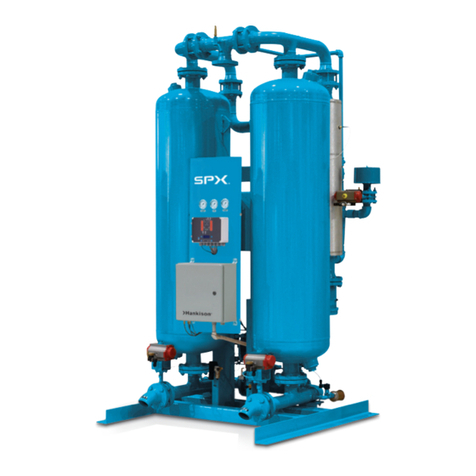
SPX
SPX HPD Series User manual
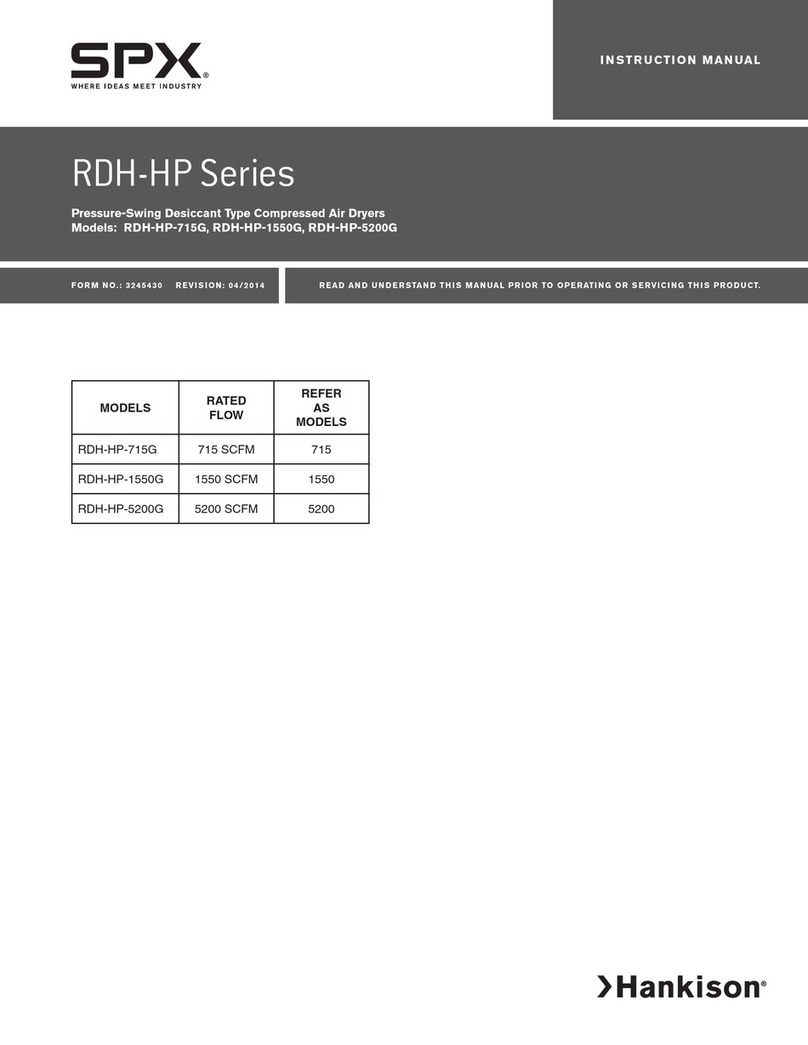
SPX
SPX RDH-HP Series User manual

